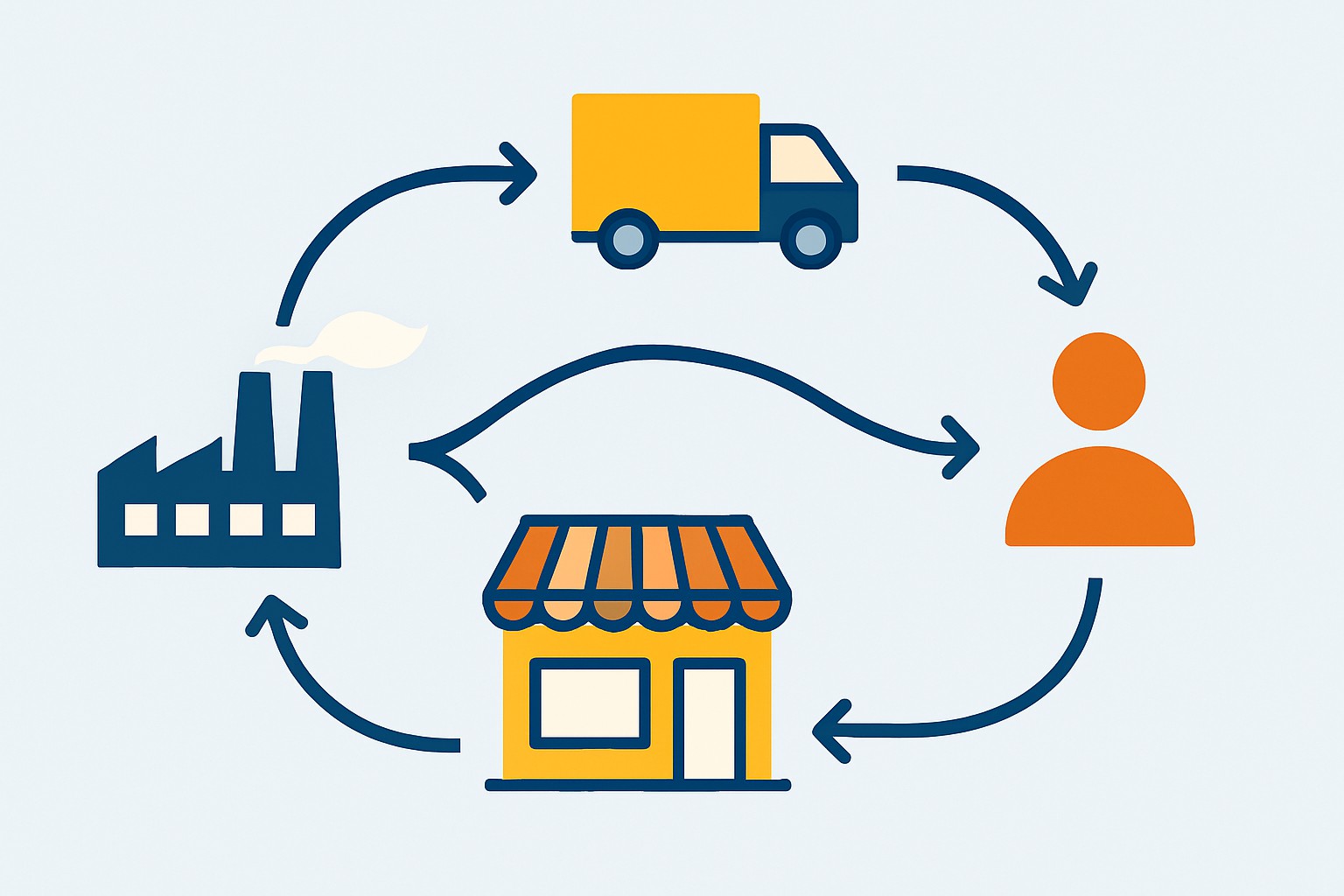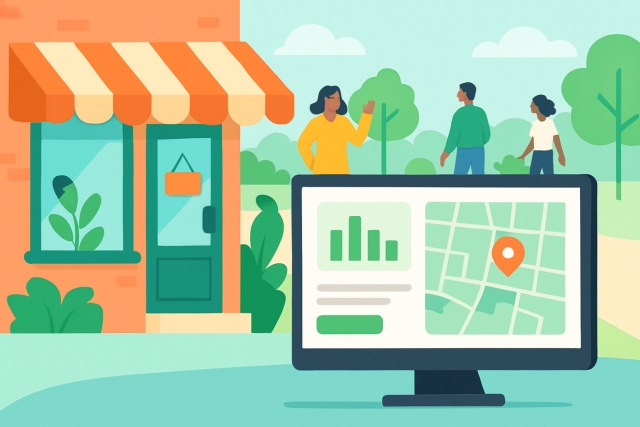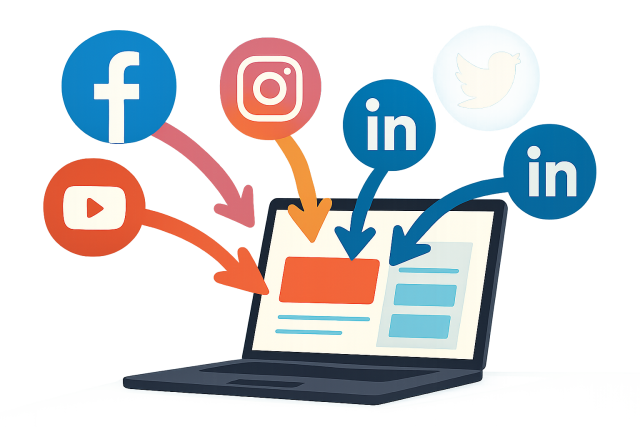Distribution Channel Types Every Marketer Should Know


Distribution channels are essentially the lifelines that link products or services with customers, ferrying them from producers or manufacturers straight into the hands of the people who actually use them. For marketers, understanding what distribution channels really are and the diverse forms they can take is absolutely key to smoothing out the journey products take to reach consumers.
So, what exactly is a Distribution Channel anyway?
A distribution channel is the path a product or service takes from the moment it is created to when it finally lands in the customer's hands. Think of it as a delivery pipeline where products navigate through various steps or middlemen before they reach you. For example, a manufacturer might sell products directly to buyers or those products could stop with wholesalers or retailers before reaching you.
Distribution channels are central to marketing and business success because they dictate how easily customers can get products, influence pricing strategies and shape the brand experience. A solid channel ensures products show up on time and stay available without extra costs. Picking the right channels can be a game-changer. It widens your market reach, boosts customer satisfaction and forges stronger brand loyalty.
Main Roles of Distribution Channels
Let’s dive into the core jobs these distribution channels handle—think of them as the backstage crew making sure the show runs smoothly. From getting products from the makers to the hands of eager customers, their role is pivotal, and honestly, without them, things would be a bit chaotic. They bridge the gap, handle the nitty-gritty logistics, and often save the day when it comes to timing and availability. It’s not just about moving stuff; it’s about creating value along the way—kind of like the unsung heroes of the supply chain saga.
- Getting goods from the manufacturer to the consumer and making sure products are right where they’re needed when they’re needed.
- Breaking down bulky shipments into smaller sizes so customers can grab just what they want without hassle.
- Keeping a close eye on inventory by storing and managing stock levels to keep up with what customers want.
- Passing along valuable market insights and customer feedback to producers because who better knows what’s working than the buyers?
- Lending a hand with financing efforts like extending credit to retailers or customers to smooth the purchase process.
- Sharing the burden of risks like damage, theft or products going out of style among all people involved in the distribution chain.
- Taking charge of marketing communications to promote products and keep consumers informed.
These functions help products find their way to consumers efficiently and effectively while adding extra value and convenience along the journey. Marketers can lean on these channel roles to keep a tighter grip on inventory, uncover valuable customer insights and give sales a solid nudge with well-targeted promotions and dependable supply chains.
A Quick Dive into the Main Types of Distribution Channels
Distribution channels can vary quite a bit depending on the product or market and business model at play. Getting a clear sense of the main types is essential for marketers aiming to pick the best path that fits their goals and aligns with what customers actually want.
Direct Distribution Channel is the straight shot from maker to buyer with no middlemen messing things up.
Indirect Distribution Channel means your product makes a few pit stops through wholesalers or retailers before landing in customers' hands.
Dual Distribution is a bit of a juggling act because you sell directly and through intermediaries at the same time.
Reverse Distribution Channel is a clever route for getting products back like returns, repairs, or recycling.
Hybrid Distribution Channel is a mix-and-match approach that keeps options open and combines various channels to reach customers most effectively.
1. Direct Distribution Channel
Sometimes, going straight to the source is the best move. A direct distribution channel cuts out the middlemen, letting businesses connect with customers in a more personal, hands-on way. It’s like skipping the line at your favorite coffee shop—straight to the good stuff. This approach often means better control over branding, pricing, and customer experience, though it does keep you on your toes with more responsibility. In my experience, it’s a bit like being both the chef and the waiter; you get to make sure everything’s just right, but you also have to juggle a lot more plates.
A direct distribution channel is when the manufacturer or service provider sells straight to the consumer and skips any middlemen along the way. This can happen through company-owned stores, a dedicated sales team or online sales platforms—basically wherever the business can connect directly with its customers.
- More control over the brand experience and how customers actually engage with it which is a game changer.
- The chance to gather direct feedback straight from the source giving valuable insights that can really help fine-tune products and services.
- Usually higher profit margins since you’re cutting out the middlemen—always a nice bonus.
- On the flip side, challenges often include ramped-up operational costs and a typically smaller market reach thanks to limited visibility which can be a bit of a headache.
2. Indirect Distribution Channel
Sometimes, the best way to reach customers is not by going straight to them but by letting a trusty middleman do the heavy lifting. That is the essence of an indirect distribution channel—a bit like having a friend who knows the neighborhood better than you do, helping you get your product to the right doorstep without breaking a sweat. It might add an extra step or two, but often, it smooths out the bumps and broadens your reach in ways direct sales just can’t match.
Wholesalers, retailers, agents or distributors step in to help move products from producers to customers. These middlemen wear many hats by handling marketing and selling and managing inventory. Sometimes they even pitch in with after-sales support. Companies often lean on these indirect channels to tap into well-established networks.
- Helps businesses expand their market reach quicker and more efficiently, saving precious time and effort.
- Lightens the load when it comes to juggling sales and logistics, so teams can breathe a little easier.
- Comes with challenges, like giving up some control over pricing and how customers feel about the brand.
- Involves splitting profit margins with middlemen, which can put a slight dent in overall earnings.
| Feature | Direct Distribution | Indirect Distribution |
|---|---|---|
| Control over branding | High – you call all the shots on messaging, no middlemen involved | Moderate – shared with intermediaries, so some give and take here |
| Customer interaction | Direct, you get immediate feedback straight from the horse’s mouth | Limited, as feedback usually gets filtered through various channels |
| Cost implications | Higher costs due to building infrastructure and staffing up, but you get full control | Lower day-to-day expenses, though margins take a hit since they’re shared |
| Market reach | Restricted mostly by your own resources, so growth can be a slow burn | Often wider reach thanks to established networks already in place |
| Pricing flexibility | Full freedom to set your prices just the way you want | Limited — intermediaries often have the final say on pricing |
| Suitability | Best fit for premium or luxury products and bespoke services that need a personal touch | Ideal for mass-market goods and fast-moving consumer products you want to get out there quick |
| Examples | Brand-owned stores and company websites where you’re the boss | Retail chains, wholesalers, and agents handling the heavy lifting |
3. Dual Distribution Channel A Two-Way Street Worth Taking
Dual distribution kicks in when a company decides to mix things up by using both direct and indirect channels to get its products into customers' hands simultaneously. This strategy can be a real game-changer allowing businesses to tap into various markets and customer segments while striking a balance between keeping control and ensuring broad availability.
Companies like Apple play the dual distribution game by selling their products not only through their own sleek Apple Stores but also via authorized retailers scattered worldwide. This clever move really helps amp up brand visibility and connects with customers who come with all sorts of buying motivations.
4. Reverse Distribution Channel
Here they circle back — think returns, recycling, or resale. It is like the business world's way of hitting the rewind button, turning what could be waste into fresh opportunities. Not the typical forward march, but a clever detour that keeps things moving in a loop we all benefit from.
Unlike traditional channels that just send products out to customers, reverse distribution channels handle the often overlooked journey back. This includes product returns, recycling, refurbishing and proper disposal. As the buzz around sustainability keeps growing louder, these reverse channels have quietly become unsung heroes in trimming down waste and recovering value from used goods while pushing forward circular economy goals.
5. Hybrid Distribution Channel
Sometimes, sticking to just one way of getting your products out there isn’t enough. That’s where a hybrid distribution channel steps in—mixing and matching different paths to market like a well-blended cocktail. It’s a clever approach that lets businesses cover more ground, reach a wider audience, and adapt on the fly when the market throws a curveball. Think of it as not putting all your eggs in one basket but rather spreading them across a few—smart, flexible, and often a lifesaver in today’s fast-moving world.
Hybrid distribution channels mix different types such as online direct sales, retail stores and wholesale distributors all rolled into one. They usually cater to different customer groups or regions at the same time with the goal of casting a wider net in the market.
Hybrid channels offer broad reach and flexibility but require careful juggling to keep branding consistent and avoid channel conflicts. They also ensure the customer experience flows smoothly at every turn.

Visual diagram showing the different distribution channel types and their flow from manufacturer to customer.
Key Factors That Really Tip the Scales When Choosing a Distribution Channel
- How complex the product is and whether it makes more sense to sell it directly to customers or use middlemen who might smooth the way.
- What customers are really after including their favorite shopping spots and how much they value convenience.
- The goals around covering the market and deciding between casting a wide net with intensive distribution or being more selective.
- The costs tied to logistics, infrastructure and the margins different channels demand which can feel like a balancing act worthy of a tightrope walker.
- How much control the company wants to keep over the brand’s experience and pricing, sometimes holding the reins tightly and other times letting go.
- The availability and how well technology like e-commerce platforms or CRM systems can be woven in to make everything tick smoothly.
- What the competition is up to and the usual industry habits that steer channel choices whether we love it or learn to live with it.
These factors dance together in a constantly shifting rhythm which means marketers really need to put on their thinking caps and carefully weigh their product, market environment and business goals before settling on a distribution strategy. Tools like Moz Pro and Mangools don’t make the decisions for you but they offer a helping hand by providing useful insights into market trends, competitor moves and consumer behavior—thanks to their SEO and data analytics features that can really shed light behind the scenes.
Common Misunderstandings About Distribution Channels
Sometimes, people get tangled up in the nitty-gritty of distribution channels, and it’s easy to see why. It’s one of those areas where even the pros can trip over a few misconceptions. So, let’s unwind some of the common mix-ups that pop up now and then.
- Relying on a single channel for all products and markets tends to miss the mark because tailored strategies usually get the job done better.
- It’s a bit of a trap to think that adding more intermediaries will somehow keep costs down. In reality, it often just drives expenses up and eats into profits.
- Direct sales channels often take the cake as they are both more effective and more profitable than their indirect counterparts.
- Distribution channels aren’t set in stone. They need to flex and adapt when the market shifts or new innovations come knocking.
These common misunderstandings can really trip up businesses when it comes to choosing the best distribution method. Some products actually need a mix of channels to hit different audiences just right, while others thrive with carefully managed intermediaries that bring something valuable to the table without sneaking costs higher. Direct sales give you more control but indirect channels often crack open the door to much bigger markets. Distribution channels are constantly evolving, especially now with digital transformation shaking up where and how customers decide to buy.
Key Approaches to Managing Distribution Channels That Really Work
- Make it a habit to regularly check how your channels are performing so you can celebrate the wins and identify spots that need a little extra TLC.
- Keep the lines of communication clear and steady along the channel to ensure everyone in the middle gets top-notch training because half-baked info won’t cut it.
- Lean on technology to monitor sales, inventory and customer feedback in real time since it is like having a finger on the pulse without breaking a sweat.
- Offer incentives and genuine support to your channel partners to boost their motivation and loyalty because everyone likes to feel appreciated.
- Stay nimble and ready to tweak your distribution game plan as market trends and customer habits shift because adaptability is often the secret sauce.
Following these best practices helps lay the groundwork for stronger partnerships and ramps up efficiency. It also makes the customer experience shine, whether you're working with what is a distribution channel or any other customer touchpoint.
Unlock Digital Marketing Success with Moz
Struggling to optimize your online presence? Moz is the ultimate Internet Marketing solution, empowering businesses with powerful SEO tools, insightful analytics, and expert guidance. Elevate your digital strategies and outshine the competition.
- Boost organic traffic with data-driven SEO tactics
- Enhance content marketing with expert recommendations
- Gain a competitive edge with comprehensive link analysis








